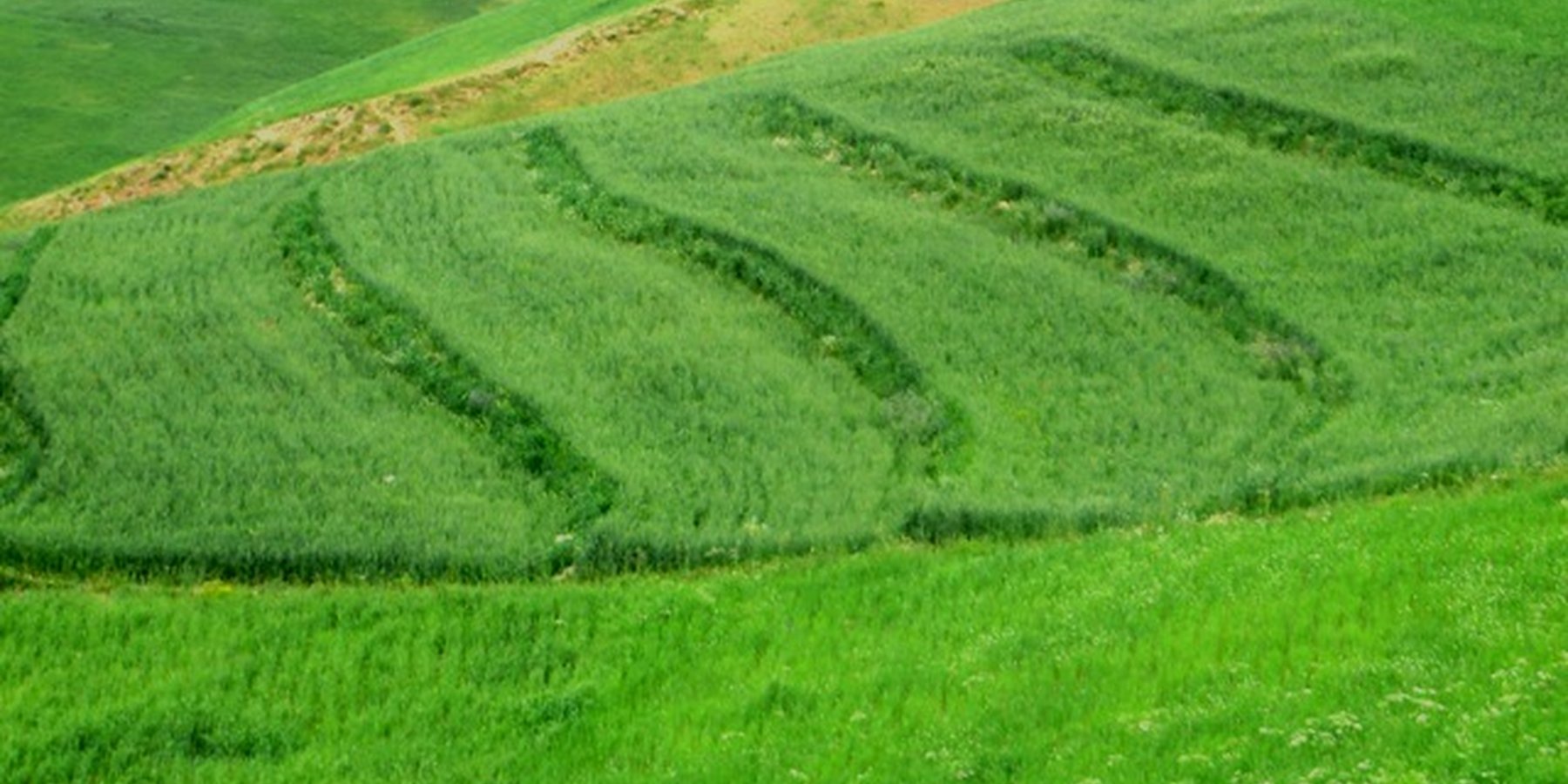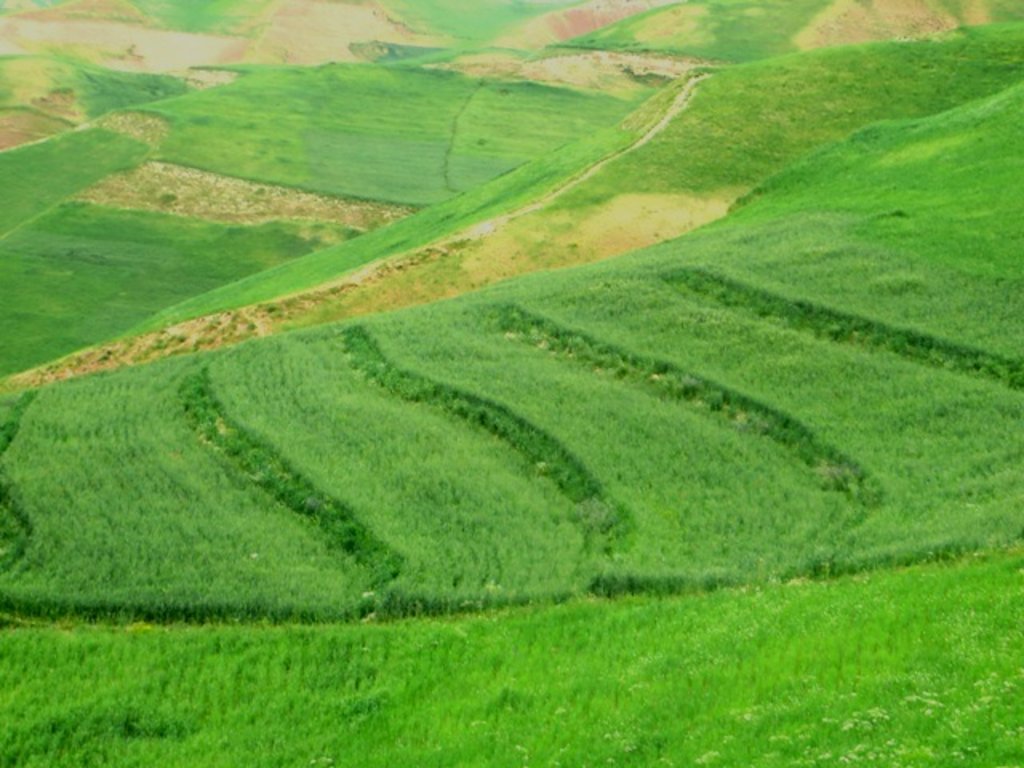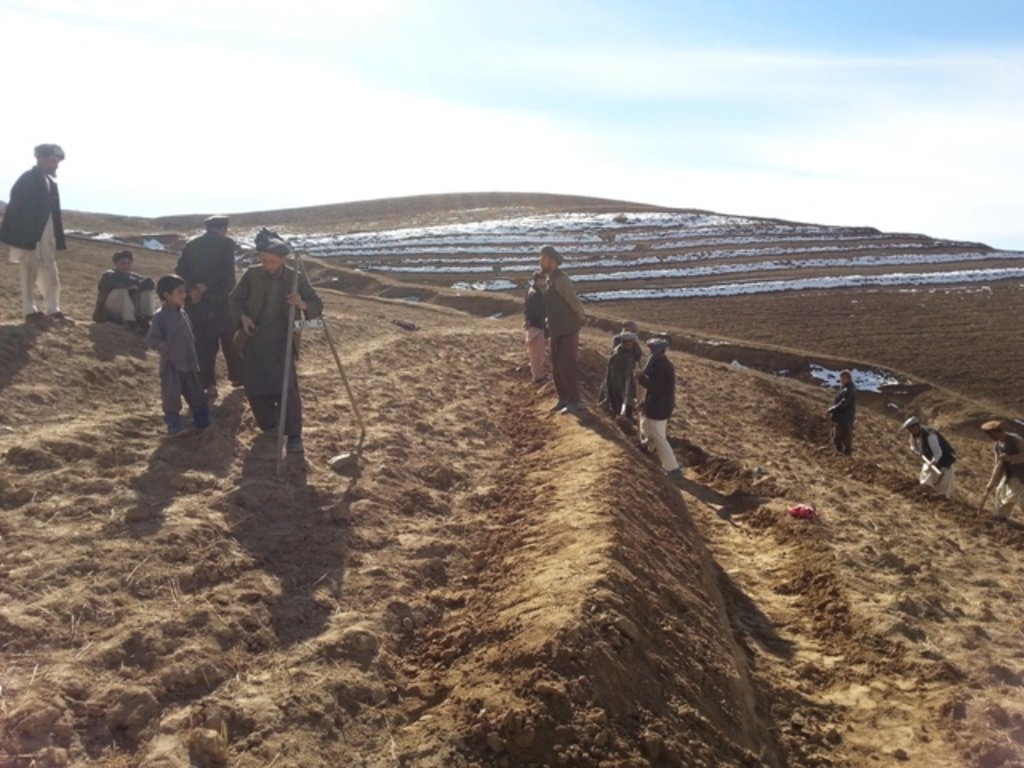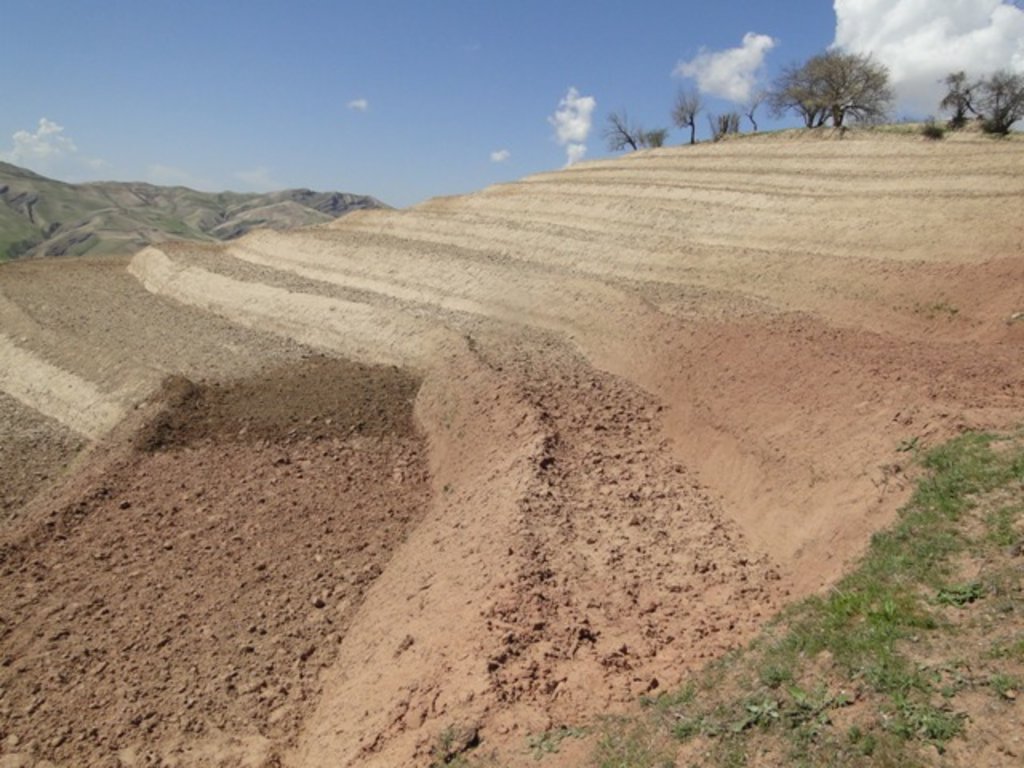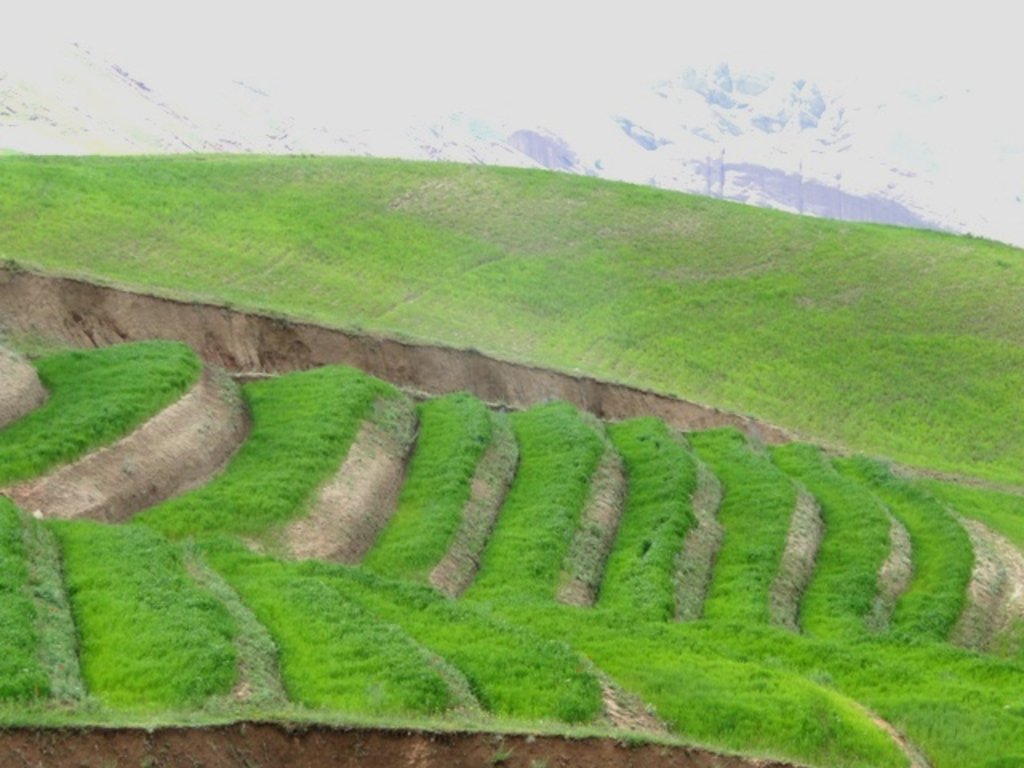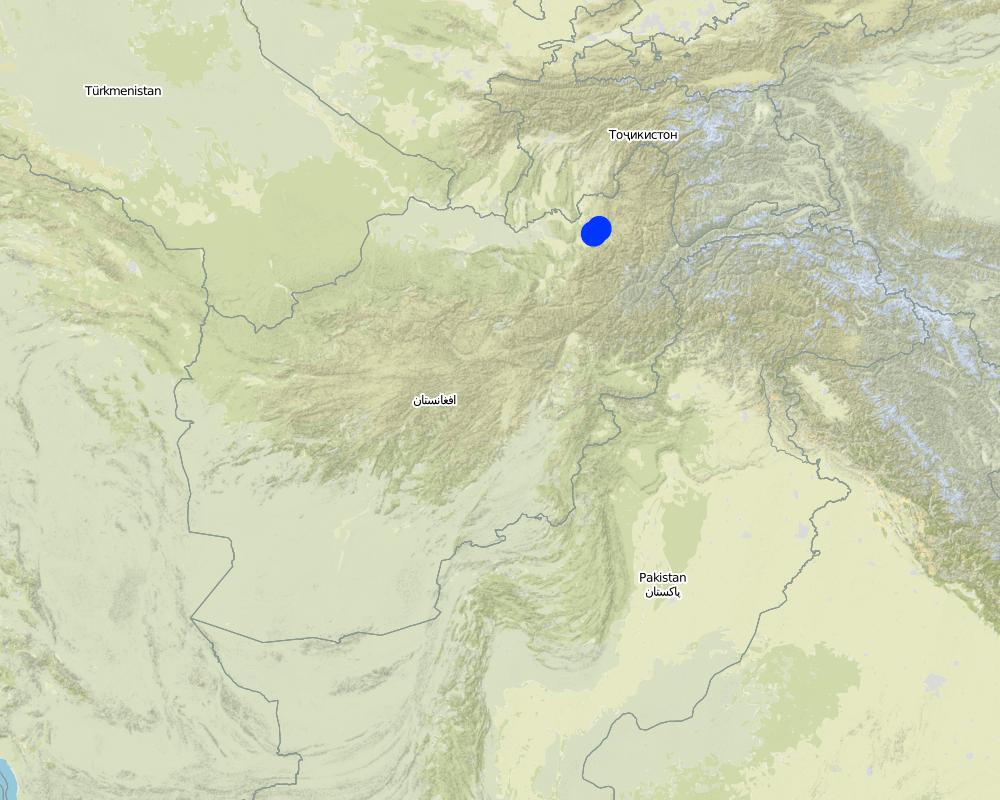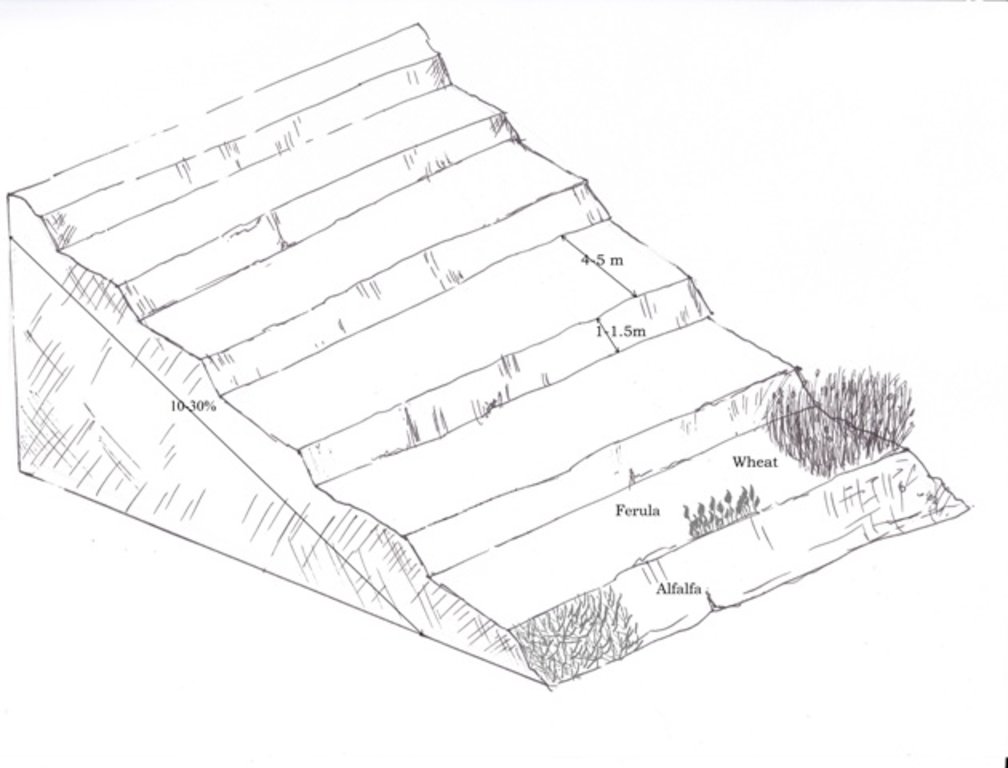Terraces with improved seed and fertilizer application [Afganistán]
- Creación:
- Actualización:
- Compilador: Roziya Kirgizbekova
- Editor: Bettina Wolfgramm
- Revisor: Rima Mekdaschi Studer
Palbandi bo tukhmihoi behbudyofta va kud
technologies_607 - Afganistán
Visualizar secciones
Expandir todo Colapsar todos1. Información general
1.2 Detalles de contacto de las personas de referencia e instituciones involucradas en la evaluación y la documentación de la Tecnología
Persona(s) de referencia clave
usuario de la tierra:
Mohammad Azim Habibullah
Natural Resources Management Comittee (NRMC)
Sari Joy Village, Takhar Province
Afganistán
Especialista MST:
Especialista MST:
Researcher:
Nombre del proyecto que financió la documentación/ evaluación de la Tecnología (si fuera relevante)
Potential and limitations for improved natural resource management (NRM) in mountain communities in the Rustaq district, Afghanistan (Rustaq NRM Study)Nombre del proyecto que financió la documentación/ evaluación de la Tecnología (si fuera relevante)
Livelihood Improvement Project Takhar, Afghanistan (LIPT)Nombre de la(s) institución(es) que facilitaron la documentación/ evaluación de la Tecnología (si fuera relevante)
Terre des Hommes (Terre des Hommes) - SuizaNombre de la(s) institución(es) que facilitaron la documentación/ evaluación de la Tecnología (si fuera relevante)
Swiss Agency for Development and Cooperation (DEZA / COSUDE / DDC / SDC) - SuizaNombre de la(s) institución(es) que facilitaron la documentación/ evaluación de la Tecnología (si fuera relevante)
CDE Centre for Development and Environment (CDE Centre for Development and Environment) - SuizaNombre de la(s) institución(es) que facilitaron la documentación/ evaluación de la Tecnología (si fuera relevante)
Bern University of Applied Sciences, School of Agricultural, Forest and Food Sciences (HAFL) - Suiza1.3 Condiciones referidas al uso de datos documentados mediante WOCAT
¿Cuándo se compilaron los datos (en el campo)?
17/10/2016
El compilador y la/s persona(s) de referencia claves aceptan las condiciones acerca del uso de los datos documentados mediante WOCAT:
Sí
1.4 Declaración de la sostenibilidad de la Tecnología descrita
¿La Tecnología aquí descrita resulta problemática en relación a la degradación de la tierra, de tal forma que no puede considerársela una tecnología sostenible para el manejo de la tierra?
No
Comentarios:
SLM practices documented in the frame of the Rustaq NRM study were established only recently (1-3 years ago). It is too early for a final judgment on the sustainability of these technologies within the human and natural environment of Chokar watershed.
1.5 Referencia al (los) Cuestionario(s) de Enfoques MST
2. Descripción de la Tecnología MST
2.1 Breve descripción de la Tecnología
Definición de la Tecnología:
Terraces are established on mountain slopes used mainly for cropping wheat, with the purpose of soil protection from erosion, preserving runoff, sediments and nutrients on-site. Improved seeds and fertilizer are applied on the terraces for increasing crop yield, but also vegetation cover and biomass production, and thus prevent further land degradation.
2.2 Descripción detallada de la Tecnología
Descripción:
Project supported implementation of terraces with application of improved seeds and fertilizer has taken place in the villages Sari Joy, Jawaz Khana and Dashti Mirzai, located in Chokar watershed of Rustaq District in Northern Afghanistan. The Chokar watershed is a mountainous area situated between 600 - 2,500 m above sea level. The climate is semi-arid with harsh and cold weather in winter and hot and dry summers. The annual precipitation in average years is 580mm. Land degradation affects all forms of land use and includes low vegetation cover, heavy top soil erosion from water, and poor soil fertility. Unsustainable agricultural practices, over-exploitation and high pressure on the natural resources are adversely impacting on the socio-economic well-being of local communities as well as contributing to the risk for being adversely affected by drought as well as landslides and flash floods triggered by heavy rainfall.
The data used for the documentation of the technology is based on field research conducted in Chokar watershed, namely in the villages: Sari Joy, Jawaz Khana and Dashti Mirzai. These villages represent the upper, the middle and the lower zone of Chokar watershed, respectively. They differ considerably in access to services and infrastructure, but in general are poorly served. The communities depend mainly on land resources for sustaining their livelihoods. In a good year with high yields, wheat-self-sufficiency lasts about 5 months.
Since 2012 the Livelihood Improvement Project Takhar (LIPT) implemented by Terre des hommes (Tdh) Switzerland has initiated a range of NRM interventions. The project introduced terraces as sustainable land management practices on private plots, situated on rolling (11-15%) and hilly (16-30%) slopes to protect the land from soil erosion and prevent the loss of water and fertile topsoil, seeds and fertilizers. The average plot size for terrace implementation is 2 Jerib (0.4 hectares) with contour strips of 40m x 4m. The height of the risers is 1m-1,5 m. Terrace benches are built along the contour by moving the soil above the bench downwards. The leveled benches of the terrace are cultivated with wheat. The risers of the terrace are mostly used for growing fodder crops, mostly alfalfa, which also helps to stabilize the terrace. If medicinal herbs (ferula) are included they are cultivated along the bench contours .
Maintenance activities include small repair work on the riser by adding some amount of soil and re-sowing of alfalfa seeds on those spots.
The terraces allow application of improved seeds and fertilizers without them being washed off. The land-users report noticeable increase of wheat yield from the terraced plot with application of improved seeds and fertilizer compared to the non-terraced plot. An average plot of 0.2 ha on non-terraced hilly cropland used to give about 70 kg of wheat (350kg/ha). On terraces the yield has increased/ doubled to 140 kg on the same plot area (700kg/ha). The expectations regarding terraces remain high as over the time the land user hope their land will become more stable and improved soil moisture and fertility will have positive impact on the productivity as well. However, so far no cost-benefit assessment has been conducted allowing attribution of individual measure to the wheat increase.
Many land users are interested in the terrace technology due to a number of environmental and economic benefits expected, however the costs for building the terrace are considered high by an average local land user. They have to rely on external support in order to have sufficient resources for implementation. Women considered an advantage that during the establishment phase, men were paid by the project to work on their own land (or other villagers land) when building the terraces. Thus, there was no need for men to go for seasonal labour migration and they stayed at home.
2.3 Fotografías de la Tecnología
2.5 País/ región/ lugares donde la Tecnología fue aplicada y que se hallan comprendidos por esta evaluación
País:
Afganistán
Región/ Estado/ Provincia:
Takhar Province, Rustaq District
Especifique más el lugar :
Chokar Watershed: Sari Joy (upper watershed), Jawaz Khana (middle watershed), Dashti Mirzai (lower watershed)
Comentarios:
This documentation is based on the experiences of SLM impementers from Sari Joy (8 terraced plots), Jawaz Khana, (7 terraced plots), and Dashti Mirzai (11 terraced plots) as compiled during FGDs. The terraces located in Jawaz Khana have not been digitized yet. Additionally insights were gained through interviews in all three villages on farmers experiences and observations of terraced plots, with both SLM implementers (46) and observers (28).
Map
×2.6 Fecha de la implementación
Si no se conoce el año preciso, indique la fecha aproximada:
- hace menos de 10 años (recientemente)
2.7 Introducción de la Tecnología
Especifique cómo se introdujo la Tecnología:
- mediante proyectos/ intervenciones externas
Comentarios (tipo de proyecto, etc.):
Livelihood Improvement Project Takhar (LIPT) supported by Swiss Development Cooperation (SDC) from 2012-17
3. Clasificación de la Tecnología MST
3.1 Propósito(s) principal(es) de la Tecnología MST
- mejorar la producción
- reducir, prevenir, restaurar la degradación de la tierra
3.2 Tipo(s) actuales de uso de la tierra donde se aplica la Tecnología

Tierras cultivadas
- Cosecha anual
- Cultivos perennes (no leñosos)
Cosechas principales (comerciales y de subsistencia):
Wheat, Alfalfa
Si el uso de la tierra ha cambiado debido a la implementación de la Tecnología, indique el uso de la tierra antes de la implementación de la Tecnología.
Before implementation of the Technology, only annual crops were cultivated, with wheat as the main crop. Plots were ploughed along the countours mostly by animal traction. In recent years land users are starting to use tractors for ploughing, , where villages and plots are accessible by machinery.
3.3 Información adicional sobre el uso de tierras
Provisión de agua para la tierra donde se aplica la Tecnología:
- de secano
Número de temporadas de cultivo por año:
- 1
Especifique:
May-July
3.4 Grupo MST al que pertenece la Tecnología
- medida de pendiente transversal
3.5 Difusión de la Tecnología
Especifique la difusión de la Tecnología:
- distribuida parejamente sobre un área
Si la tecnología se halla difundida homogéneamente en un área, indique el área aproximada que cubre:
- 0.1-1 km2
3.6 Medidas MST que componen la Tecnología

medidas agronómicas
- A2: materia orgánica/ fertilidad del suelo

medidas vegetativas
- V2: Pastos y plantas herbáceas perennes

medidas estructurales
- S1: Terrazas
Comentarios:
Agronomic measures: Terraces increase the economic viability of applying improved seeds and (chemical) fertilizer to badly nutrient depleted cropland.
Vegetative measures: Alfalfa is planted on the risers for stabilizing the terraces, and as an important contribution to fodder cropping.
Structural measures: The leveling of countour strips allows to harvest water and sediments.
3.7 Principales tipos de degradación de la tierra encarados con la Tecnología

erosión de suelos por agua
- Wt: pérdida de capa arable/ erosión de la superficie
- Wg: erosión en cárcavas
- Wo: efectos de degradación fuera del sitio

deterioro físico del suelo
- Pi: sellado de suelo

degradación biológica
- Bc: reducción de la cobertura vegetal del suelo
- Bq: reducción de la cantidad/ biomasa

degradación del agua
3.8 Prevención, reducción o restauración de la degradación de la tierra
Especifique la meta de la Tecnología con relación a la degradación de la tierra:
- reducir la degradación de la tierra
- restaurar/ rehabilitar tierra severamente degradada
4. Especificaciones técnicas, actividades de implementación, insumos y costos
4.1 Dibujo técnico de la Tecnología
4.2 Especificaciones técnicas/ explicaciones del dibujo técnico
Terraces are established predominantly on a privately owned land in a mountainous landscape with varying steepness of slopes.
The average size of a plot is 2 Jerib, which is equal to 0.4 ha. The design of the terrace depends on the steepness of the slope. Mostly rolling (11-15%) and hilly (16-30%) slopes are used for building terraces.
Using an A-frame, the terrace is designed by dividing the slope into contour strips. Depending on the slope steepness, the terrace bench is around 4m wide and the the height of the risers is 1m-1,5 m. The terrace benches are built along the contour by moving the soil of upper bench to the lower bench. The leveled benches of the terrace are cultivated with wheat. The risers of the terrace are mostly used for growing fodder crops, such as alfalfa, which also helps to stabilize the terrace. If medicinal herbs are included, such as ferula, they are cultivated along the bench contours.
4.3 Información general sobre el cálculo de insumos y costos
Especifique cómo se calcularon los costos e insumos:
- por área de Tecnología
Indique tamaño y unidad de área:
1 ha
Especifique la moneda usada para calcular costos:
- dólares americanos
Indique la tasa de cambio de USD a la moneda local (si fuese relevante): 1 USD =:
67,0
Indique el costo promedio del salario de trabajo contratado por día:
5.2-5.3 USD
4.4 Actividades de establecimiento
| Actividad | Tipo de medida | Momento | |
|---|---|---|---|
| 1. | Selection of the area for establishing a terrace (Men) | Manejo | Autumn |
| 2. | Designing of the terrace using A-frame, assisted by trained technician/project staff (Men) | Estructurales | End of autumn after rainy days |
| 3. | Leveling the soil with a shovel (Men) | Estructurales | Autumn/Winter |
| 4. | Sowing of alfalfa seeds on the risers (Men/women) | Vegetativas | After 20 days of sowing wheat |
| 5. | Sowing of wheat seeds on benches (Men/Women) | Agronómicas | Winter/Spring |
| 6. | Sowing of ferula along the contours (Men/women) | Vegetativas | Winter/Spring |
4.5 Costos e insumos necesarios para el establecimiento
| Especifique insumo | Unidad | Cantidad | Costos por unidad | Costos totales por insumo | % de los costos cubiertos por los usuarios de las tierras | |
|---|---|---|---|---|---|---|
| Mano de obra | Designing of the terrace using A-frame | person-day | 10,0 | 9,0 | 90,0 | |
| Mano de obra | Leveling the soil with a shovel | person-day | 150,0 | 5,3 | 795,0 | 51,0 |
| Mano de obra | Sowing of wheat and alfalfa seeds | person-day | 10,0 | 5,3 | 53,0 | 51,0 |
| Mano de obra | Sowing of ferula | person-day | 2,0 | 5,3 | 10,6 | 100,0 |
| Equipo | Pick axe | Pcs | 1,0 | 3,0 | 3,0 | 100,0 |
| Equipo | Pitchfork | Pcs | 1,0 | 5,3 | 5,3 | 100,0 |
| Equipo | Wheel barrow | Pcs | 1,0 | 38,0 | 38,0 | 100,0 |
| Equipo | Shovel | Pcs | 1,0 | 3,8 | 3,8 | |
| Equipo | Hoe | Pcs | 1,0 | 7,5 | 7,5 | |
| Equipo | A-Frame | Pcs | 1,0 | 6,0 | 6,0 | |
| Material para plantas | Wheat seeds | Kg | 140,0 | 0,42 | 58,8 | |
| Material para plantas | Alfalfa seeds | Kg | 17,5 | 0,42 | 7,35 | 100,0 |
| Material para plantas | Ferula seeds | Kg | 2,5 | 6,35 | 15,88 | 100,0 |
| Fertilizantes y biocidas | DAP | Kg | 125,0 | 0,9 | 112,5 | |
| Fertilizantes y biocidas | Urea | Kg | 125,0 | 0,45 | 56,25 | |
| Fertilizantes y biocidas | Herbicide | Liter | 50,0 | 0,25 | 12,5 | |
| Costos totales para establecer la Tecnología | 1275,48 | |||||
Si el usuario de la tierra no cubrió el 100% de los costos, indique quién financió el resto del costo:
Livelihood Improvement Project Takhar (LIPT) implemented by Terre des Hommes (Tdh)
Comentarios:
Equipment provided by the project was re-used for the implemenation of different SLM practices on different plots. For completness equipment costs are fully accounted for.
Costs calculated for a Technology area of 1ha was only done for the purpose of the WOCAT documentation. In reality SLM plots are on average 0.4 ha or 2 jiribs. Costs were simply multiplied by 2.5. The actual costs for a 1ha plot might be slightly different.
4.6 Actividades de establecimiento/ recurrentes
| Actividad | Tipo de medida | Momento/ frequencia | |
|---|---|---|---|
| 1. | Ploughing the land with animal traction (Men) | Agronómicas | Winter/Spring/Annually |
| 2. | Sowing of wheat seeds on benches (Men/Women) | Agronómicas | Winter/Spring/Annually |
| 3. | Application of fertilizer (Men/Women) | Agronómicas | Fall |
| 4. | Weeding (Women) | Agronómicas | Summer |
| 5. | Harvesting wheat (Men and women together) | Agronómicas | Summer/Fall |
| 6. | Harvesting alfalfa (Men and women together) | Agronómicas | Summer/Fall |
| 7. | Collecting and delivering harvested wheat (Men and women) | Agronómicas | Fall |
| 8. | Collecting and delivering harvested alfalfa (Men and women) | Agronómicas | Fall |
| 9. | Repairing terrace risers with a shovel (Men) | Estructurales | Winter/Spring/After heavy rain or snow |
| 10. | Sowing alfalfa seeds on the repaired area (Men/Women) | Vegetativas | Winter/Spring/When required |
4.7 Costos e insumos necesarios para actividades de mantenimiento/ recurrentes (por año)
| Especifique insumo | Unidad | Cantidad | Costos por unidad | Costos totales por insumo | % de los costos cubiertos por los usuarios de las tierras | |
|---|---|---|---|---|---|---|
| Mano de obra | Ploughing the land with animal traction | person day | 2,5 | 5,3 | 13,25 | 100,0 |
| Mano de obra | Sowing of wheat seeds on benches | person day | 5,0 | 5,3 | 26,5 | 100,0 |
| Mano de obra | Weeding and Fertilizer application | person day | 5,0 | 5,3 | 26,5 | 100,0 |
| Mano de obra | Harvesting and delivering wheat and alfalfa | person day | 70,0 | 5,3 | 371,0 | 100,0 |
| Equipo | Sickle | Pcs | 1,0 | 100,0 | ||
| Material para plantas | Wheat seeds | Kg | 140,0 | 0,42 | 58,8 | 100,0 |
| Fertilizantes y biocidas | DAP | Kg | 125,0 | 0,9 | 112,5 | 100,0 |
| Fertilizantes y biocidas | Urea | Kg | 125,0 | 0,45 | 56,25 | 100,0 |
| Fertilizantes y biocidas | Herbicide | Liter | 50,0 | 0,25 | 12,5 | 100,0 |
| Indique los costos totales para mantenecer la Tecnología | 677,3 | |||||
Si el usuario de la tierra no cubrió el 100% de los costos, indique quién financió el resto del costo:
Livelihood Improvement Project Takhar (LIPT) implemented by Terre des Hommes (Tdh)
Comentarios:
Costs calculated for a Technology area of 1ha was only done for the purpose of the WOCAT documentation. In reality SLM plots are on average 0.4 ha or 2 jiribs. Costs were simply multiplied by 2.5. The actual costs for a 1ha plot might be slightly different.
4.8 Factores más determinantes que afectan los costos:
Describa los factores más determinantes que afectan los costos:
Due to the remoteness of the villages where the Technology has been implemented, all the inputs for establishment, such as agricultural equipment, plant material, fertilizers, etc., are purchased in Rustaq town. The expenses for traveling and delivering the inputs affect the establishment costs.
5. Entorno natural y humano
5.1 Clima
Lluvia anual
- < 250 mm
- 251-500 mm
- 501-750 mm
- 751-1,000 mm
- 1,001-1,500 mm
- 1,501-2,000 mm
- 2,001-3,000 mm
- 3,001-4,000 mm
- > 4,000 mm
Especifique el promedio anual de lluvia (si lo conoce), en mm:
580,00
Especificaciones/ comentarios sobre la cantidad de lluvia:
Average annual precipitation for the area was calculated with 580 mm, with minimums in dry years (2000 and 2001) of 270 mm and maximums in wet years (2009/2010) of 830 mm. The absolute maximum rainfall was calculated for 1986 with 1024 mm. The data series covers the time from 1979 to 2014.
Indique el nombre de la estación metereológica de referencia considerada:
Climate Forecast System Reanalysis (CFSR), http://rda.ucar.edu/pub/cfsr.html
Zona agroclimática
- semi-árida
Specifications: Derived from the publically available dataset on length of growing period (LGP) (Fischer 2009 / IIASA-FAO). Internet link: http://tiles.arcgis.com/tiles/P8Cok4qAP1sTVE59/arcgis/rest/services/Length_of_growing_period/MapServer
5.2 Topografía
Pendientes en promedio:
- plana (0-2 %)
- ligera (3-5%)
- moderada (6-10%)
- ondulada (11-15%)
- accidentada (16-30%)
- empinada (31-60%)
- muy empinada (>60%)
Formaciones telúricas:
- meseta/ planicies
- cordilleras
- laderas montañosas
- laderas de cerro
- pies de monte
- fondo del valle
Zona altitudinal:
- 0-100 m s.n.m.
- 101-500 m s.n.m.
- 501-1,000 m s.n.m
- 1,001-1,500 m s.n.m
- 1,501-2,000 m s.n.m
- 2,001-2,500 m s.n.m
- 2,501-3,000 m s.n.m
- 3,001-4,000 m s.n.m
- > 4,000 m s.n.m
Comentarios y especificaciones adicionales sobre topografía :
The information was derived from two different sources:
- SLM implementers information provided in the Land User Protocol (LUP) during an FGD
- Elevation and slope statistics derived for terraced plots from ASTGTM. ASTGTM is the ASTER Global Digital Elevation Model V002 with a 30 m spatial resolution. More information on ASTGTM is available here: https://lpdaac.usgs.gov/node/1079. The data can be downloaded here: https://gdex.cr.usgs.gov/gdex/
5.3 Suelos
Profundidad promedio del suelo:
- muy superficial (0-20 cm)
- superficial (21-50 cm)
- moderadamente profunda (51-80 cm)
- profunda (81-120 cm)
- muy profunda (>120 cm)
Textura del suelo (capa arable):
- mediana (limosa)
Textura del suelo (> 20 cm debajo de la superficie):
- mediana (limosa)
Materia orgánica de capa arable:
- media (1-3%)
- baja (<1%)
Si se halla disponible, adjunte una descripción completa de los suelos o especifique la información disponible, por ej., tipo de suelo, pH/ acidez de suelo, capacidad de intercambio catiónico, nitrógeno, salinidad, etc. :
Local land users differentiate between the following soil types where terraces are implemented:
- Light soils: moderately deep; texture of topsoil medium (loamy, silty); low topsoil organic matter
- Dark soils: moderately deep; texture of topsoil medium (loamy, silty); medium topsoil organic matter
5.4 Disponibilidad y calidad de agua
Disponibilidad de aguas superficiales:
mediana
Calidad de agua (sin tratar):
agua potable de buena calidad
¿La salinidad del agua es un problema?
No
¿Se está llevando a cabo la inundación del área? :
Sí
Frecuencia:
frecuentemente
Comentarios y especificaciones adicionales sobre calidad y cantidad de agua:
Floods occur mainly during the rainy seasons in spring and autumn. Availability of surface water differs for the three study villages Sari Joy, Jawaz Khana, and Dashti Mirzai. Sari Joy has sources and good surface water availability. Jawaz Khana has poor water availability as water has to be fetched from a lower laying stream. Dashti Mirzai has good water availability also from an irrigation channel.
5.5 Biodiversidad
Diversidad de especies:
- baja
Diversidad de hábitats:
- baja
5.6 Las características de los usuarios de la tierra que aplican la Tecnología
Sedentario o nómada:
- Sedentario
Orientación del mercado del sistema de producción:
- subsistencia (autoprovisionamiento)
- mixta (subsistencia/ comercial)
Ingresos no agrarios:
- 10-50% de todo el ingreso
- > 50% de todo el ingreso
Nivel relativo de riqueza:
- promedio
- rico
Individuos o grupos:
- individual/ doméstico
Nivel de mecanización:
- trabajo manual
- tracción animal
Género:
- mujeres
- hombres
Edad de los usuarios de la tierra:
- personas de mediana edad
- ancianos
5.7 Área promedio de la tierra que pertenece a o es arrendada por usuarios de tierra que aplican la Tecnología
- < 0.5 ha
- 0.5-1 ha
- 1-2 ha
- 2-5 ha
- 5-15 ha
- 15-50 ha
- 50-100 ha
- 100-500 ha
- 500-1,000 ha
- 1,000-10,000 ha
- > 10,000 ha
¿Esto se considera de pequeña, mediana o gran escala (refiriéndose al contexto local)?
- escala mediana
5.8 Tenencia de tierra, uso de tierra y derechos de uso de agua
Tenencia de tierra:
- individual, sin título
Derechos de uso de tierra:
- individual
Derechos de uso de agua:
- comunitarios (organizado)
Comentarios:
Those who own land and use water for irrigation are obliged to pay for the water. The payment is made both in kind and in cash to the Mirob, the person in charge of distributing water in the community. The amount of the payment varies from village to village.
6. Impactos y comentarios para concluir
6.1 Impactos in situ demostrados por la Tecnología
Impactos socioeconómicos
Producción
producción de cultivo
Cantidad antes de MST:
350 kg / ha
Cantidad luego de MST:
700 kg / ha
Comentarios/ especifique:
The integration of measures including agronomic (improved seed and fertilizer) and structural (terraces to control water flow and loss of top soil, including nutrients and seeds) results in an increase of crop yield already in the first year. The effects cannot be attributed to one or the other measure specifically.
producción de forraje
Comentarios/ especifique:
Alfalfa is planted on the risers.
diversidad de producto
área de producción
Comentarios/ especifique:
No change in total area for production, as the riser of the terraces are used for fodder production. However, there is some reduction of area available for annual crop production.
Impactos socioculturales
seguridad alimentaria/ autosuficiencia
Comentarios/ especifique:
The yield of the main staple crop (wheat)has been reported to be double on terraced plots with application of improved seed and fertilizer. In addition, fodder crops, such as alfalfa grown on the risers, can be harvested.
MST/ conocimiento de la degradación de la tierra
Comentarios/ especifique:
Technicians in the villages were trained in the use of A-frames. Implementers of terraces voiced that they themselves would not be able to replicated the designing of terraces.
situación de grupos en desventaja social y económica
Comentarios/ especifique:
Female headed households are not included. Technology is implemented on private land, therefore people without land are excluded. However, they have the opportunity to earn income as a hired worker for the SLM implementers.
Impactos ecológicos
Ciclo de agua/ escurrimiento de sedimento
escurrimiento superficial
Suelo
humedad del suelo
Comentarios/ especifique:
in situ water harvesting
pérdida de suelo
Biodiversidad: vegetación, animales
Cubierta vegetal
Comentarios/ especifique:
Both an increase in vegetation cover during the growing season when most erosive rains are observed as well as permenant vegetation cover from perennial alfalfa plants can been observed.
biomasa/ sobre suelo C
6.2 Impactos fuera del sitio demostrados por la Tecnología
inundaciones río abajo
colmatación río abajo
capacidad de amortiguación/ filtrado
Comentarios acerca de la evaluación del impacto:
These comments apply to 6.1 and 6.2:
- Socio-economic impacts: Based on the Land User Protocols: Individual SLM implementers were asked to rate the benefits for their Technology. They were asked to indicate production increase of crops; fodder; animals; wood; non-wood forest products; increase in product diversity; or production area. The most important increase they rated with 3, the second most with 2, others with 1 point. Averages of the points given by all SLM implementers are reflected here.
- Ecological impacts and off-site impacts: Based on the Land User Protocols: Individual SLM implementers were asked to rate the on-site and off-site impacts of the Technology on water; soil; and vegetation. They were asked to indicate the strength of impacts with three, two or one points. Averages of the points given by all implementers are reflected here.
6.3 Exposición y sensibilidad de la Tecnología al cambio climático gradual y a extremos relacionados al clima/ desastres (desde la percepción de los usuarios de tierras)
Extremos (desastres) relacionados al clima
Desastres climatológicos:
| ¿Cómo es que la tecnología soporta esto? | |
|---|---|
| tormenta de lluvia local | muy bien |
Desastres climatológicos
| ¿Cómo es que la tecnología soporta esto? | |
|---|---|
| sequía | bien |
Comentarios:
Based on the multi-criteria matrix: SLM implementers from three villages were asked to jointly discuss and rate how much the SLM technology reduced the lands vulnerability to drought and local rainstorms. Only vulnerability to the most prevalent climate extremes (drought and local rainstorms) was discussed. SLM technologies were rated as reducing vulnerability poorly , well, or very well. The average points reflected here are from multi-criteria matrices compiled in three villages where the SLM technology had been implemented.
6.4 Análisis costo-beneficio
Comentarios:
Costs: As larger parts of the establishment of the technology were covered by the project, farmers consideration of the total costs are likely underestimated.
Benefits: Two plots were terraced in 2012, and 5 plots in 2013. However, most terraces were implemented in 2014 (11 plots ) and 2015 (8 plots). The Rustaq NRM study was conducted in autumn 2016. 1-2 years of cultivating the terrace system is too short a period for providing evidence on short- and long-term returns.
6.5 Adopción de la Tecnología
- 1-10%
Si tiene la información disponible, cuantifique (número de hogares y/o área cubierta):
10.7 ha has been terraced within the 3 study villages with LIPT project support.
De todos quienes adoptaron la Tecnología, ¿cuántos lo hicieron espontáneamente, es decir, sin recibir incentivos/ pagos materiales?
- 0-10%
Comentarios:
Based on the Land User Protocol: Individual SLM implementers were asked whether they received support for implementing the Technology. Each indicated the type of support he received from the proposed options: "Full Support 100%, Some Support, No Support 0%". 3 implementers claimed full project support, 22 claimed some support, and 1 implementer claimed no project support.
6.6 Adaptación
¿La tecnología fue modificada recientemente para adaptarse a las condiciones cambiantes?
Sí
Si fuera así, indique a qué condiciones cambiantes se adaptó:
- mercados cambiantes
Especifique la adaptación de la Tecnología (diseño, material/ especies, etc.):
Ferula is planted on the terrace in addition to wheat and alfalfa. The resin-like gum from the dried sap extracted from the stem and roots of Ferula is in high demand as a basic product for pharmaceuticals. Ferula can be sold to local merchants, who resell it to India, and is thus intercropped by some farmers on the terraces.
6.7 Fuerzas/ ventajas/ oportunidades de la Tecnología
| Fuerzas/ ventajas/ oportunidades desde la perspectiva del usuario de la tierra |
|---|
| Notable higher crop yields on the plots where improved seeds and fertilizer are applied on newly established terraces. Farmers have high expectations for the years to come and for yields of annual crops (such as wheat) to remain high. |
| Diversity of crops planted on terraces is valued by the land users. For example, cultivating wheat and alfalfa on the terraced plot provides household with the key crop and also fodder for the livestock and thereby contributes to securing food for the family and maintaining better health of their cattle. Additionally, some farmers have started intercropping Ferula, a medical herb and cash crop. |
| Farmers percieve soil quality on terraced plots with fertilizer application to improve. An improvement in soil fertility (which may relate first of all to the effects of fertilizer application) and increased soil moisture have been reported. Single statements also related to effectiveness of applying fertilizer on terraced plots, as here fertilizer is not washed away during rains. |
| Terraced plots are considered less vulnerable to the effects of rainstorms and dry spells, than non-terraced plots on slopes where annual crops are cultivated. |
| Women considered an advantage that during the establishment phase, men were paid by the project to work on their own land when building the terraces. Thus, there was no need for men to go for seasonal labour migration and they stayed at home. At the same time the terracing of the land is seen as an opportunity to improve the land resources on their families plots. An increase in women's workload related to bringing food to the field during establishment was considered to be acceptable, especially compared to the expected increase in yields. |
| Fuerzas/ ventajas/ oportunidades desde la perspectiva del compilador o de otra persona de referencia clave |
|---|
| The application of fertilizer on terraces is expected to show multiple effects: yields from these fertility depleted croplands can be increased. This includes an increase in biomass production, which may be used as green manure on the field or as animal feed or as straw. Further, vegetation cover during the growing period can be increased, which helps to protect the soil from erosive rains. |
| The project paid establishment of terraces on farmers' plots provided 20 days of employment per 2 jerib (0.4 ha) plot for farmers in their home villages. At the same time the terracing is a long-term investment into the land resources. Terracing provides an opportunity to decrease soil degradation and even to rehabilitate degraded lands. Application of improved seeds and fertilizer contribute in the establishment year to increased crop and fodder yields. |
6.8 Debilidades/ desventajas/ riesgos de la Tecnología y formas de sobreponerse a ellos
| Debilidades/ desventajas/ riesgos desde la perspectiva del usuario de la tierra | ¿Cómo sobreponerse a ellas? |
|---|---|
|
The implementation costs are high and land users state that it is impossible for them to cover establishment costs on their own. |
|
| Farmers expectations partly exceeded the actual yield harvested from the terraces in the first years after the implementation. | |
| Both men and women from households that have implemened terraces state that during the establishment year the household experiences an increased workload, that is not well compatible with other on-going household / farm activities. | |
| The production area for annual crops only is slighty reduced. | So far not all farmers seem to use the production area fully. Intercropping with perennial plants is recommended in order to use the risers of the terraces for fodder production. Some farmers have started intercropping of Ferula as cash crop. |
| Sufficient own land is required. | How does the amount of cropland affect the innovation readiness of a farmer? A better understanding is required on farmers willingness to take a risk for investing in a new SLM technology, and especially terracing, and influencing factors. |
| Debilidades/ desventajas/ riesgos desde la perspectiva del compilador o de otra persona de referencia clave | ¿Cómo sobreponerse a ellas? |
|---|---|
| The technology requires technical knowledge for implementation and maintenance, which is key for successful adoption, replication and upscaling. The project trained technicians to support land users with the design of terraces. While the project aided implementation of terraces has improved the general knowledge and awareness of the land users on the benefits of SLM practices, most farmers will not be able to design terraces on their own. | |
|
Technically correct design of the terrace presents a challenge and might not be always achieved. Forward sloping terrace benches may lead to channeled runoff and have the risk of rills and gully formation. |
|
| There is an attribution gap regarding the increased wheat yields, especially with regard to individual contribution of the terraces, the application of improved seeds and the fertilizer, and the combined effects (role of terraces in making improved seed and fertilizer application effective). | A cost benefit analysis (CBA) needs to be conducted to determine short- and long-term returns of the SLM technology. On farm trials are necessary for assessing impacts of the different measures (agricultural, vegetative and structural measures) before-and-after, as well as with-without the SLM technology. |
| Terrace maintenance is crucial. If not maintained properly for a longer period of time, the damaged terrace can lead to further land degradation through channeled runoff, sever erosion and possible risks of disaster for the surrounding settlements on the slopes. | |
| The technology is established mainly by better-off households, which own more land than the average SLM implementer. |
7. Referencias y vínculos
7.1 Métodos/ fuentes de información
- entrevistas con usuarios de tierras
Focus group discussions (FGD) were organized by the CDE team to collect information from SLM implementers. Total of 26 land users who have implemented terraces participated in the FGDs held in the three villages of Sari Joy, Jawaz Khana and Dashti Mirzai.
Interviews were conducted by the HAFL team to collect information from persons representing all the three study villages. Very detailed interviews were conducted with 74 persons interested in terrace implementation, of which 46 persons are from households that already have implemented terraces.
- entrevistas con especialistas/ expertos en MST
The technical staff of Tdh LIPT Project in Rustaq, responsible for the implementation of the technology were consulted on a number of occasions during the compilation of this material.
- compilación de informes y otra documentación existente
Information provided in the reports of Tdh LIPT Project in Rustaq served as an initial source of information during the preparatory phase and also solidifying the description of the technology and area of implementation. Other background papers on Afghanistan were referred to for general information on agriculture and natural resource management in Afghanistan.
Vínculos y módulos
Expandir todo Colapsar todosVínculos
No hay vínculos
Módulos
No se hallaron módulos


